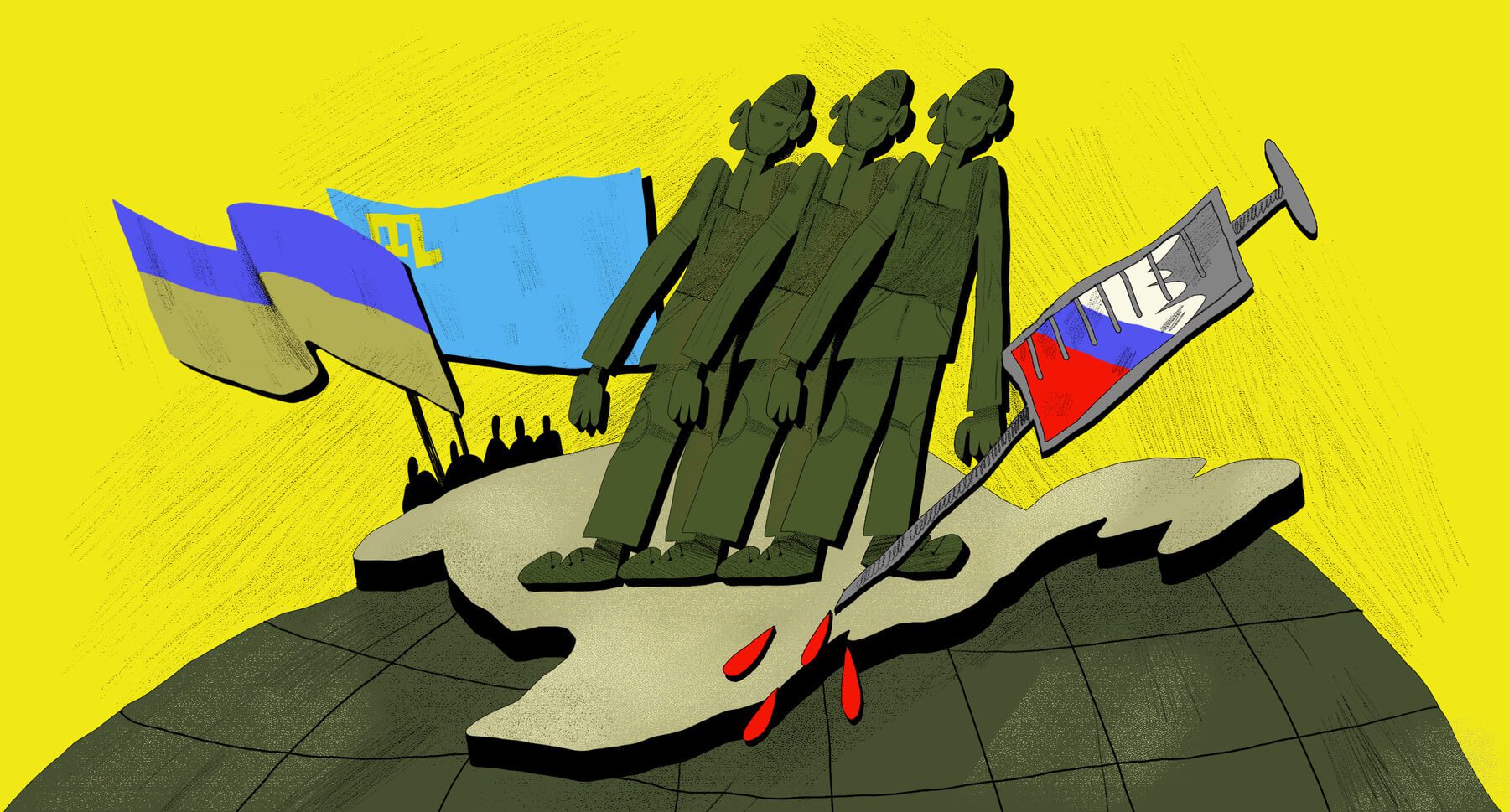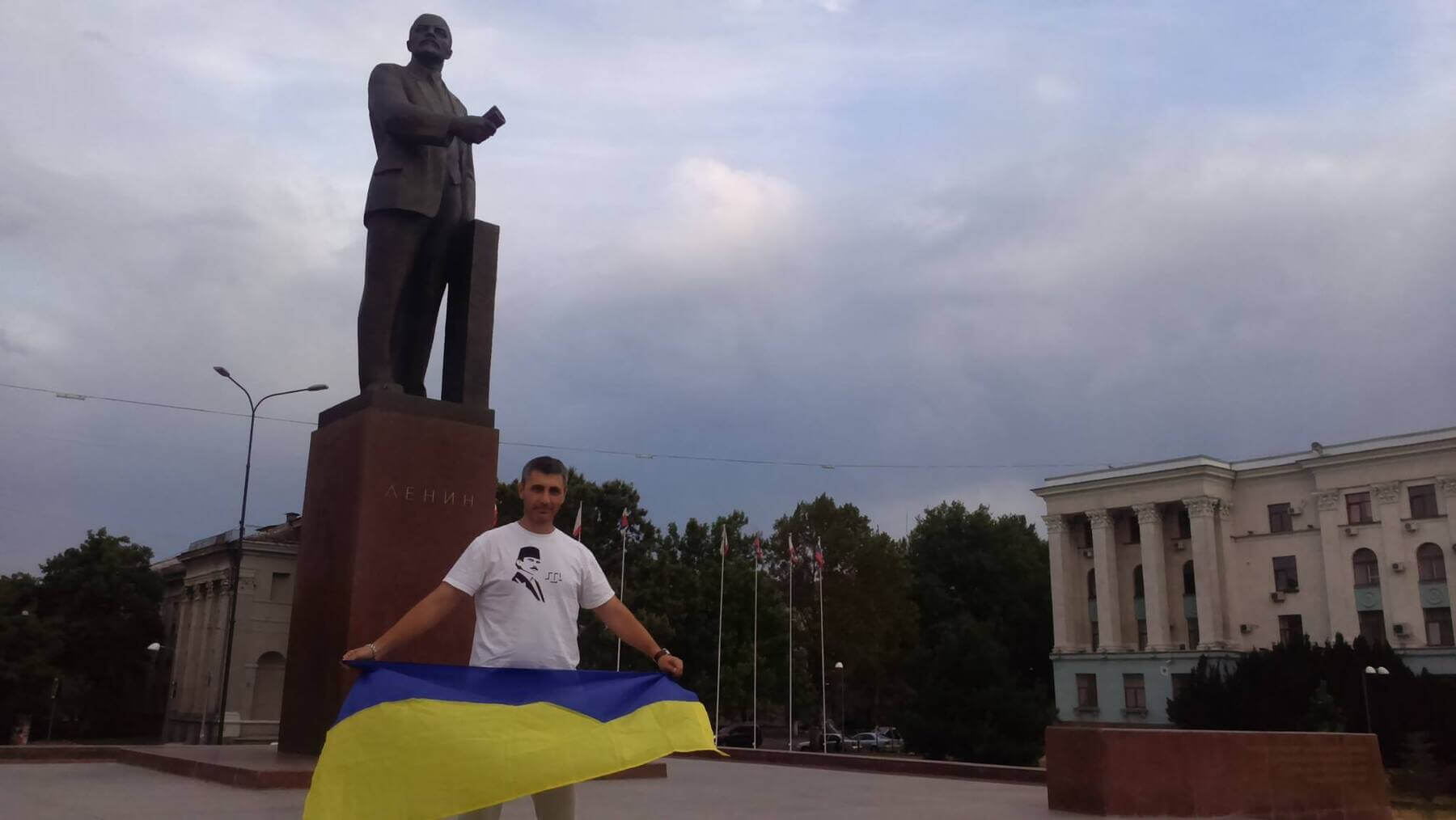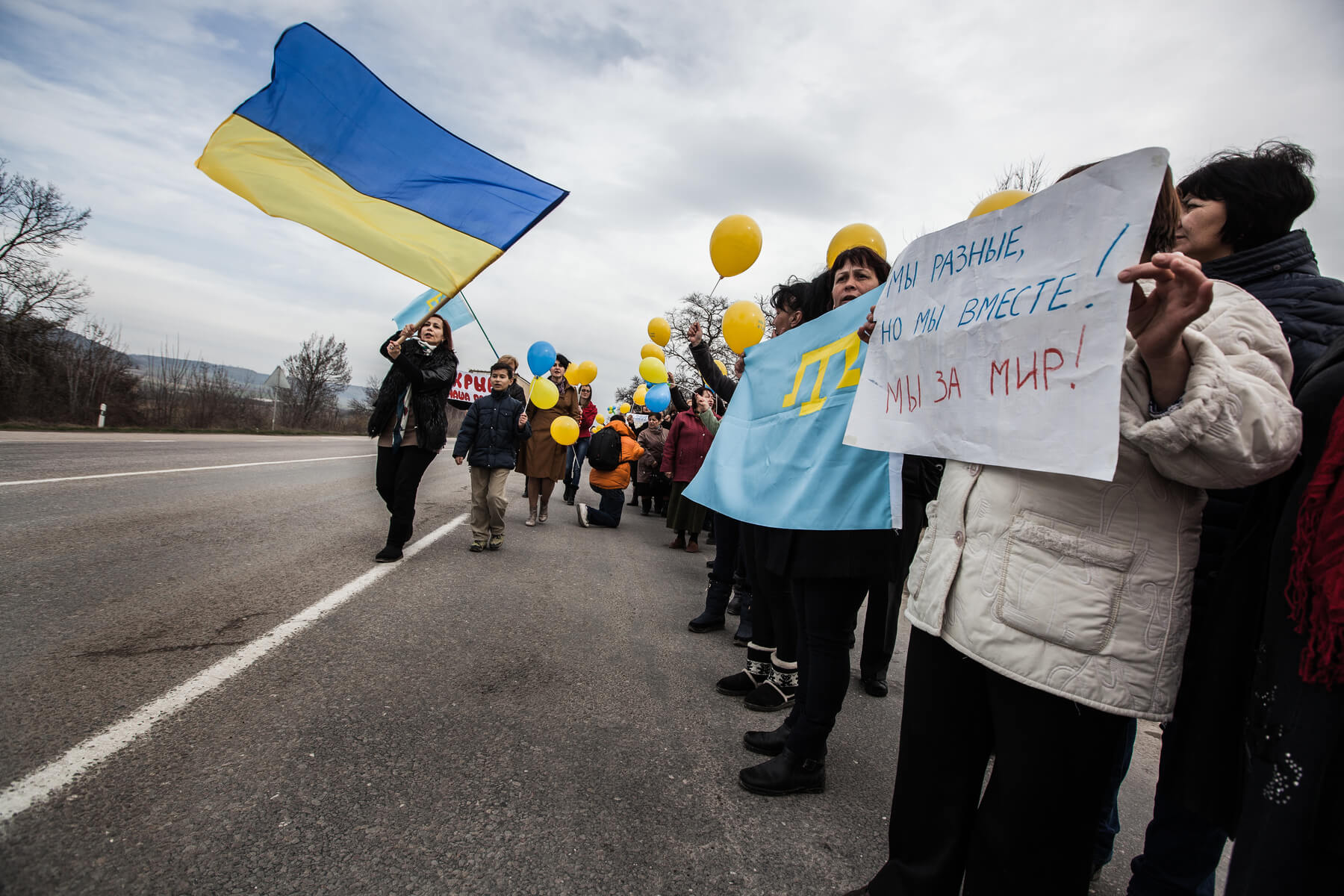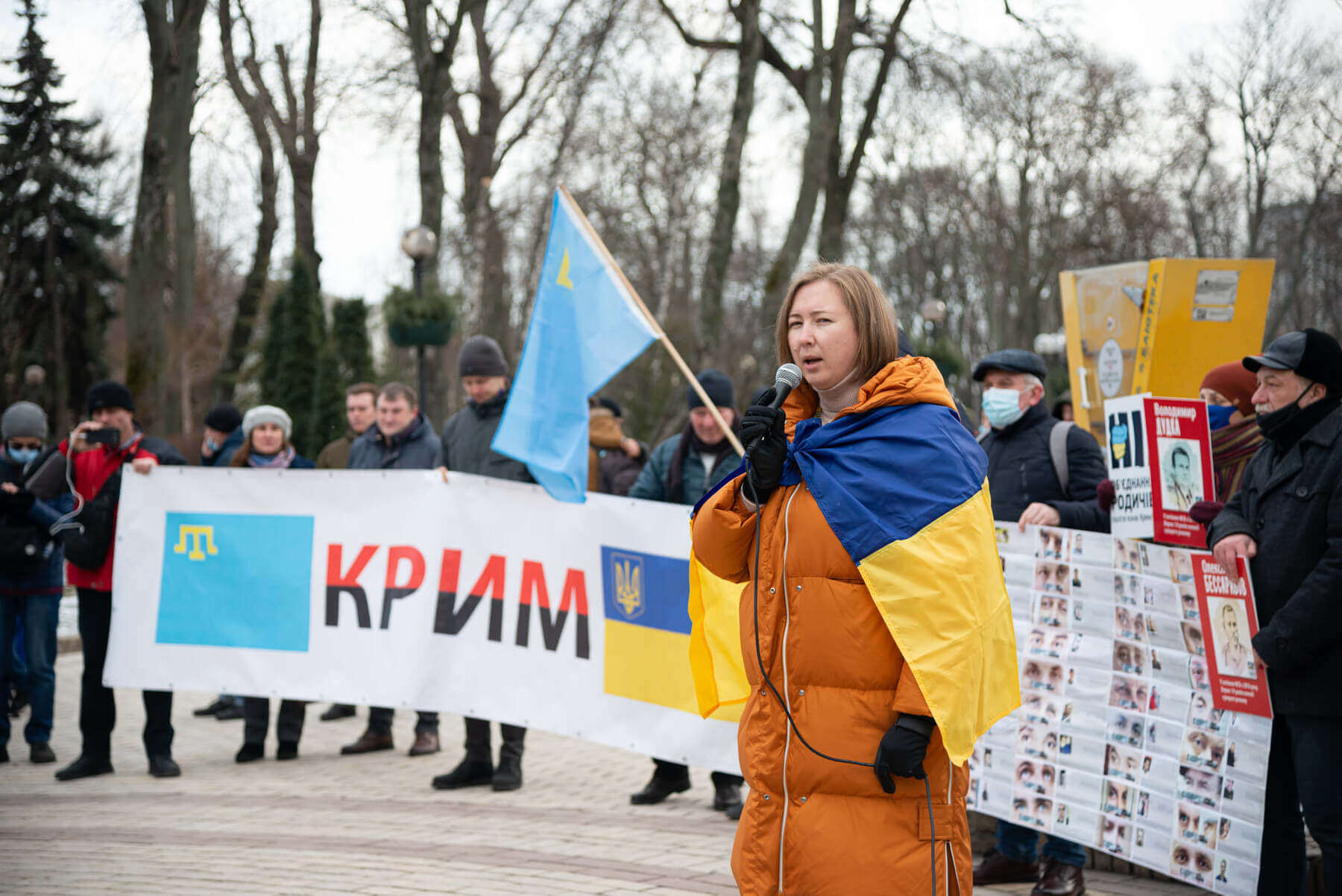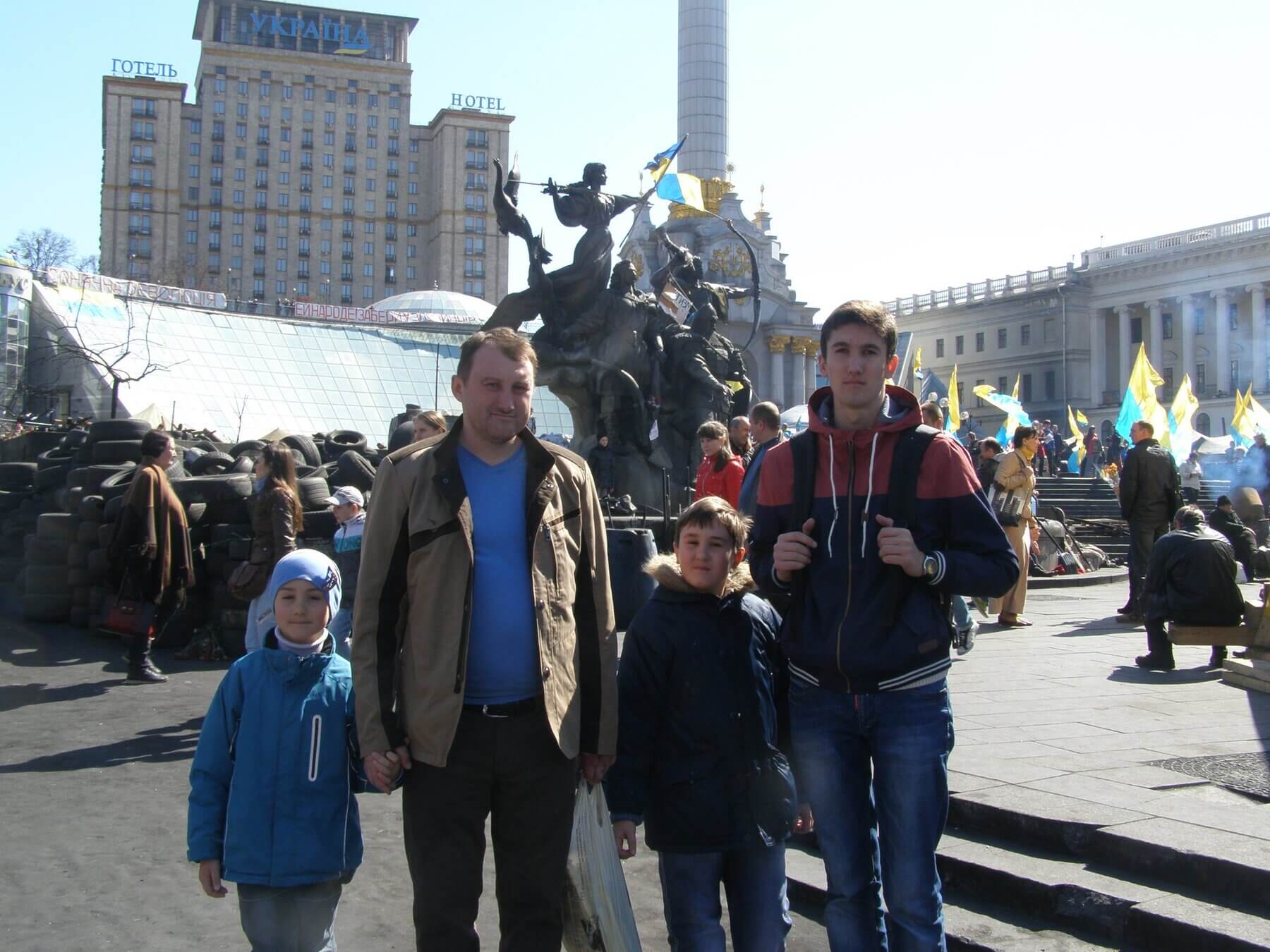On February 20, 2014, the world’s attention was focused on the bloodiest events on the Maidan in Kyiv during the Revolution of Dignity. On the same day, the first recorded cases of the Russian Armed Forces violating the border of Ukraine in the Kerch Strait occurred. Russian Armed Forces stationed in Crimea were involved too.
In 2015, the Verkhovna Rada will officially recognize this day as the date of the beginning of the occupation of Crimea. The aggressor would not pretend either — by that time, Russia had already minted the departmental awards of the Ministry of Defense “For the Return of Crimea” with the dates “20.02.14–18.03.14” engraved on the reverse. This is how the occupation of Ukrainian Crimea began.

Illustration: Kateryna Kruhlyk / Zaborona
Slow Russification
“Before 2014, they tried to occupy Crimea repeatedly,” says Andriy Shchekun, one of the coordinators of the Euromaidan-Crimea movement and organizer of pro-Ukrainian rallies in Simferopol. “When we received the status of the Autonomous Republic of Crimea, we already lost because it was imposed on us by Russia. It was in fact an “autonomous republic of Crimea” with a Russian national majority, funded by Russia. Ukrainians in Crimea needed help and a proper state policy. In 1993–1994, completely pro-Russian forces came to power in Crimea. They were led by Yuri Meshkov [the first and only president of the Autonomous Republic of Crimea, chairman of the Council of Ministers], and a war with Meshkov’s people began. They even introduced Moscow time in Crimea. Pro-Ukrainian Crimeans then rebelled. Another attempt took place during the Orange Revolution, but the law enforcement agencies intervened. The Alpha special group then took control of all the FSB officers who worked for the Russian Federation and cut off their communication.”
Journalist Tetiana Kurmanova, who worked at the Crimean Center for Investigative Journalism in 2014, also speaks about the planned occupation: “Russia has been preparing the occupation for a long time, various scenarios have been worked out. In Crimea, they said that no country should be allowed such freedom on the territory of another country. There were a lot of Russian military retirees with real estate in Crimea. The pro-Russian military movements felt quite free, and this was allowed by the Ukrainian authorities. Russia has always used both the cultural field and the educational field — it was much easier for applicants from Crimea to enter universities in St. Petersburg under quotas than in Simferopol or Kyiv.”
The editor-in-chief of the Krymska Svitlytsia newspaper, Andriy Shchekun, predicted in one of his articles that the Russian occupation could take place in 2017, when the agreement on the status and conditions of the Russian Black Sea Fleet’s stay in Ukraine would expire. However, Russia was ahead of all predictions.

Illustration: Kateryna Kruhlyk / Zaborona
“Little green men” and the so-called self-defense of Crimea
On February 24, 2014, Russian Navy ships in Novorossiysk took on board military equipment, the so-called “little green men” — Russian soldiers without the insignia of the Russian Armed Forces — and headed for Sevastopol.
“When people entered Yanukovych’s house [on February 21, 2014, Viktor Yanukovych fled Kyiv], we had hope that everything would change, because the revolution had won,” says Iryna Sedova, a Crimean journalist and researcher at the Crimean Human Rights Group. “The organizers of the Crimean Euromaidan gathered people on the square to talk about what had happened. Among the crowd were FSB agents and militants in civilian clothes. When I was speaking, they started throwing eggs and ran at us. One guy was beaten badly. We managed to hide behind law enforcement officers who were still trying to protect us. They told us that they saw local law enforcement officers bought by Russians handing out money to attack us.”
On February 26, a rally of local Ukrainian patriots and Crimean Tatars for the territorial integrity of Ukraine was held near the Verkhovna Rada [the parliament] of the ARC. The date was approved as the Day of Resistance to the Russian Occupation of Crimea.
“About 20 thousand participants of the All-Crimean peaceful rally in support of the territorial integrity of Ukraine thwarted the Kremlin’s plans with their determination and courage, confirming to the whole world that Crimea is an integral part of Ukraine and the homeland of the Crimean Tatar people,” said Refat Chubarov, Chairman of the Mejlis of the Crimean Tatar people.
A rally of pro-Russian organizations took place nearby. According to some reports, it barely numbered 2,000 participants.
“In this confrontation, we won the battle against the pro-Russian protesters,” recalls Andriy Shchekun. “We pushed them back and took control of the Crimean parliament. But our mistake was that we went home. Maidan did not go home, but we did.”
The next day, Russian soldiers without insignia blocked the buildings of the Crimean parliament and the government of the republic in Simferopol.
“For us, those who lived in Crimea at the time, the date of the beginning of the occupation was the morning of February 27, when Russian military and armored vehicles appeared on the streets, and the buildings of the Crimean government and parliament of the autonomy were seized,” recalls Andriy Klymenko, project manager at the Institute for the Black Sea Strategic Studies. “In the morning, I received a photo of military armored vehicles from my colleagues in Simferopol. They asked what kind of vehicles were these. I identified them as Russian armored vehicles of the Tiger type, which were in service with Russian special forces. That is, it became clear that the “little green men” were Russian military. I also knew that the marines of the Russian Black Sea Fleet in Crimea did not have such equipment.”
Crimean journalist Iryna Sedova recalls: “The owner of the ferry crossing in Kerch was a Russian. He had railroad ferries that could transport trains. He immediately loaded military equipment onto those ferries and brought it from the Kuban region of Russia to Crimea. The military tried to remove the chevrons, but the license plates on all the vehicles were Russian. We saw all these Grads MRLs coming in. We were threatened for that, we were chased.”
“As early as 5 a.m., Russian flags were up in Crimea,” says Tatiana Kurmanova, “The sane Crimeans thought that an anti-terrorist operation would be conducted, and that Alpha units would probably come. Unfortunately, we did not see it. Instead, we watched Ukrainian military bases being surrounded.”

Illustration: Kateryna Kruhlyk / Zaborona
Blockade of military bases in 2014. The first abductees in Crimea
“Next to the military unit on Subhi Street in Simferopol, there was a military enlistment office,” recalls lawyer Elzara Shukurdzhieva, wife of Crimean Tatar activist Veldar Shukurdzhiev. “My husband said: ‘I need to go to the military enlistment office, they must be gathering the military right now.’ When we passed by the military unit, we saw our young soldiers standing there — such fear in their eyes! My husband said: ‘Guys, don’t be afraid, we are with you.’ We approached the military enlistment office, but it was closed. As we walked back, we saw an armored personnel carrier and a burly soldier with an assault rifle. My husband asked who they were. The soldier said: ‘Get out of here, move on.’”

Veldar Shukurdzhiyev. Photo provided by Elzara Shukurdzhiyeva
Journalist Tetiana Kurmanova recalls: “Everyone was waiting for an answer from the power vertical. Viacheslav Selezniov, one of the few officials who told us what was happening in the military units, said: we were just told to hold on. Sometimes they said that it was probably time to change the cockades on our caps. There was uncertainty. Ukrainian soldiers were blocked by “little green men” in all the military units of Crimea. The Russians began to manipulate the military, saying they were abandoned, and promising more money. And many really had that feeling, because they weren’t even getting food. There was a feeling that Crimea was being surrendered.”
On February 28, 2014, the Verkhovna Rada of the Autonomous Republic of Crimea voted at gunpoint to hold a “referendum on the status of Crimea.” A representative of the Russian Unity Party, Sergei Aksyonov, became the head of the Crimean government. Meanwhile, the land entrances to Crimea from the Kherson region were blocked, Simferopol and Belbek airports were closed, and officers of the now-disbanded Crimean special unit of the Ministry of Internal Affairs of Ukraine “Berkut” appeared at checkpoints.
Elzara Shukurdzhieva says: “There were many neighborhoods in Simferopol where Crimean Tatars lived. And literally all the women came out, lining up along the Sevastopol highway. There were thousands of them — with posters and flags. My mother-in-law, who could barely walk, came. As well as a friend of mine, who was very cautious and afraid of everything. All the women were cooking something for the military: samsa, flatbread, pilaf. The men were on duty at night. It was a desperate desire to change something.”

Crimean Tatar women rallying against the war between Russia and Ukraine on the road between Simferopol and Sevastopol in Crimea, Ukraine on March 8, 2014. Photo: Daniel van Moll/NurPhoto/NurPhoto/Corbis via Getty Images
The head of the board of the Crimean Human Rights Group, Olga Skrypnyk, together with her husband and friends, organized the Yalta Resistance Group, which helped Ukrainian border guards at the military units in Massandra and Gurzuf. “We collected information on the movement of Russian troops because the command did not communicate with our military in any way. They were abandoned, had no information. We were delivering food and medicine,” she says.
On March 3, 2014, Crimean Tatar activist Reshat Ametov was abducted in Simferopol after going out to protest against the so-called referendum in front of the Crimean government building. Two weeks later, his dead body with signs of torture was found in the forest. Ukraine considers him one of the first victims among those who opposed the occupation of Crimea.

Olha Skrypnyk. Photo provided by Olha Skrypnyk
Pressure on activists and journalists in Crimea
“There were already few independent journalists in Crimea. We were immediately put under pressure,” recalls Tetiana Kurmanova, “We rented an office in the Trade Union Building on Lenin Square for a long time. ‘The Crimean Self-Defense’ seized our building and blocked the journalists. They put us under surveillance. You call a taxi using different phone numbers, and the same driver with a Russian flag arrives. He brings you to your house, and you don’t even tell him the address anymore. I wanted to go out a block away, but he dropped me off at my house and said: ‘What, you don’t know where you live? We know everything.’ It was very telling: we know everyone, we see everything, we’ll find you when we need to.”
Active obstruction of the work of pro-Ukrainian Crimean journalists began. Most of them had to leave in 2014 because they were not allowed to work.
“I came to the next meeting of this illegal body, and I was not allowed inside. A self-defense member with an assault rifle denied me entry. He said: ‘I’d rape you in the middle of this square, shoot you dead, and no one would even turn their head.’ As I looked around, I saw a stream of people pass us in a big circle and pretend that nothing was happening,” Kurmanova says.
Journalist Iryna Sedova notes that Ukrainian and international journalists came, a hub has been set up in the newsroom, and local media workers have been working as fixers.
“Of course, we were already being followed by the FSB in cars. In early March, a representative of the journalists’ union arrived with his colleague, and we went to film the Russians burying armored personnel carriers under our military units. One Russian soldier came up to our car and said, stroking his Kalashnikov: ‘Get out of here. My scope can see further than your camera.’ I realized that there was no point in me rushing at these Russian soldiers with my camera,” she recalls.
On March 9, 2014, in Simferopol, on the eve of a rally dedicated to Taras Shevchenko’s birthday, the leader of the Crimean Euromaidan, Andriy Shchekun, was detained and abducted together with his colleague Anatoliy Kovalskiy. The prisoners were released only on March 20.

Andriy Shchekun. Photo provided by Andriy Shchekun
They came to the railway station to meet the Kyiv-Simferopol train. Activists from Kyiv sent national symbols for this action.
“When I approached the conductor, about 50 people attacked me and took me to the police station screaming. I still managed to make a call and tell where I was,” Andriy shares his horrific memories, “Then buff Russians approached. They said: ‘Let’s pack them up.’ When I started to resist, they hit me in the head. They put a hood over my head, twisted my arms, and dragged me along the platform. They threw us into a car, beat us some more, and taped our eyes and hands. We were taken to the military enlistment office, as we found out later. They tortured us there: stripped us naked, tied our hands and feet to a chair, electrocuted us, and interrogated us. Gradually, the basement was filling up — there were already 30–40 people in it, activists and military. Some were wounded: there was one guy whose ear was cut off because he was mistaken for a member of the Right Sector. After the exchange, two bullets were pulled out of my arm — the consequence of pneumatic gunfire.”
Olha Skrypnyk, Head of the Board of the Crimean Human Rights Group, said: “On the night of March 16th, the Russians stormed one of the last units. The GRU [Main Intelligence Directorate of the Russian Federation] officers came to my husband and said that tomorrow is the last day when I can still be allowed to leave. Otherwise, no one would find me.”

Illustration: Kateryna Kruhlyk / Zaborona
Illegal referendum and recent pro-Ukrainian actions
On March 16, 2014, the infamous ‘referendum’ on the status of Crimea took place. The orchestrated and boycotted event contradicted the Constitution of Ukraine and all legal norms. It has not been recognized by the international community. On March 14, 2014, the Constitutional Court of Ukraine declared the resolution of the Verkhovna Rada of the Autonomous Republic of Crimea, according to which the event was held, unconstitutional.
“I still had time to visit these fake polling stations, I saw what was happening in Yalta during that ‘referendum’,” says Olha Skrypnyk, head of the board of the Crimean Human Rights Group, “It was a referendum at gunpoint. In all cities, there were Russian military — ‘little green men’ — accompanied by the GRU. At that time, Ukrainian channels were turned off, everything was covered with Soviet-style advertising, and all advertising space was seized.”
According to journalist Tetiana Kurmanova, ballots were issued to everyone without requiring any identification documents.
“It’s a farce — they wrote down a person’s name and gave them a ballot,” the journalist said. “My colleague recorded people arriving by bus and throwing in ballots. There were no attempts to create anything resembling a real vote. These falsifications were large-scale, and they violated their own rules of the game. Of course, journalists were not allowed in the polling stations, and Crimean journalists of the APR were attacked. There was information about the beating of film crews.”
At 11 p.m., people were going door-to-door saying that it was still possible to vote. “I saw through the peephole how they were writing down the names themselves. They even wrote the name of my neighbor, who did not go. When I started shouting that it was illegal, they tried to break my door. Those who did not go to the ‘referendum’ were visited at home by Russian police and forced to vote. It was arbitrariness,” states Tetiana Kurmanova.
On March 25, 2014, the Cherkasy Navy minesweeper, the last military unit with a Ukrainian flag in Crimea, was seized. The Autonomous Republic and the city of Sevastopol were completely occupied by the Russian Armed Forces. However, Ukrainian activists still remained in Crimea.

Illustration: Kateryna Kruhlyk / Zaborona
Crimean political prisoners
Persecution of Crimeans for their political views, ethnicity, or religion continues. As of March 13, 2024, the occupiers have illegally imprisoned 214 people, 135 of whom are Crimean Tatars. In February 2023, two political prisoners died: Konstantin Shiring and Dzhemil Gafarov. In addition, since February 24, 2022, Russian security forces have opened at least 699 cases under the article on the so-called discrediting of the Russian army in Crimea.
“These are terrible figures because we are talking about the illegal conviction of Ukrainian citizens. And among them are activists, human rights defenders, journalists — those who have remained patriots of their country to the end and are not ready to put up with the occupation regime. From the very beginning of the occupation, Russia has turned Crimea into a territory of fear and danger, a huge military base, and a place where human rights are systematically violated. Illegal searches and detentions have become commonplace. On March 5, a wave of massive illegal searches took place in the occupied Bakhchisarai and Dzhankoy districts in the homes of Crimean Tatars — Crimean Solidarity activists and religious leaders,” said Tamila Tasheva, the Permanent Representative of the President of Ukraine in the Autonomous Republic of Crimea.
“Until 2015, my husband brought Ukrainian literature to Crimea, and opened a library,” recalls Elzara Shukurdzhieva, “Every time the FSB waited for him on a bench outside the house. Before each event, they had him sign a paper stating that he could be arrested. He signed it and went out anyway. He’s been arrested for unfurling the Ukrainian flag. One day, when he came to Crimea, he was detained for a long time. They said: ‘Don’t come here again. If you do, no one would find you anymore.’ He realized that the games were over.”

